| After
the release of blockbuster hit Baldur's Gate, Interplay's audio
department wasted no time to start planning sound design for Planescape:
Torment. Craig Duman, Supervising Mastering engineer, began by
pouring over the Advanced Dungeons & Dragons collection of
rulebooks that define the massive Planescape universe. This in-depth
research was then used to create an effects list that eventually
reached over 1500 sounds. |
A team
consisting of 12 audio designers and engineers created the sounds
for Torment. Talent like David
Farmer of Skywalker Sound contributed more than 300 spectacular
spell effects. Farmer's credits include work on Armageddon, Mortal
Kombat, Con Air and The Mask as well as games such as Baldur's
Gate, Fallout 2 and Descent 3. Farmer molded Torment's spell effects
out of many layers of sound, and on some of Torment's dramatic
spells Farmer layered in effects over effects. He explains that,
"During Torment, I was processing some sword hits, and they were
coming up very interesting. While they didn't work for the spell
I was working on, I gave them a description like 'reverberant
metal tones, good spell source.' Later, I was looking for something
with
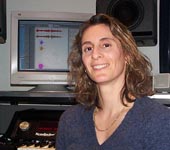
EFX's
Ann Scibelli |
those qualities,
but had forgotten I made those sounds. When I searched my database
for 'metal tones', I found them, and they were exactly what I
needed!" Other unusual sources for sound came from Skywalker's
Al Nelson. Al found an opportunity to record his teething ten-month-old
son. This howling effect found its way into Torment's Mortuary.
Ann Scibelli of EFX, sound designer on The Mod Squad and Everest,
brought Torment's creatures to life, giving each a broad set of
sounds to express the creature's unique reactions. Ann used moose
calls and employed techniques such as using a glass vase to create
intense vocalizations. These were combined with recordings of
real animals to achieve an emotional palette for Torment's myriad
life forms. Additionally, Ann created most of the sounds in Torment's
striking cinematic scenes. Audio sessions for some of these movies
exceeded 120 tracks of sound, a giant amalgam of layered ambiences
and sound effects. Ann laughs as she recalls that, "the hardest
part was just getting the computer to open the sessions!" These
sessions were later mixed together with music and dialog at Interplay's
Mix stage in Dolby Surround Sound. |
| ProTools
Session Examples: |
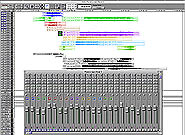
|
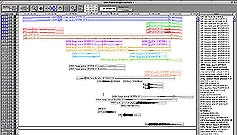
|
|
The making
of Torment effects began with ambient sound. This was to set the
tone, convey the mood of each area in the game, and ultimately
immerse the player in a deep atmosphere. Every corner in Torment
is filled with ambient noises and looping backgrounds. These sounds
even change with the time of day. "If a stove is off at night,
you can hear rats running around in the pipes, or scary demon
birds flying around outside," describes Duman. Interplay Audio
Director, Charles Deenen, created the approximately 450 ambient
effects in the game. Several weeks before Torment was to final,
Charles propositioned Interplay sound designers
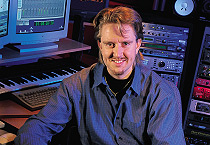
Charles Deenen |
to listen
to a looping ambient sound from Torment and try to figure out
what the original sources were for the final effect; extrapolating
a recipe from a cooked meal. The effect resembled distant crickets
chirping through an eerie wind. The cricket sound was strange,
otherworldly, but the source could have been a summer night in
the desert. That analysis was too obvious; Charles is a master
of creative sound manipulation. Loading the file back into ProTools,
the digital audio system in which the sound was created, allowed
the team to do a little investigative research into the origins
of this mysterious wind. To unlock the secret, the sound was pitched
up an octave. The ambient sound became smoother, the wind and
the cricket elements melted into each other but still there was
nothing recognizable. Another octave and behold, the familiar
hollow wailing of a….camel. It was still mutated, but the camel
call was clearly identifiable. Next day there was another ambient
to examine for its creative origins. This one was surely a wind,
odd, but surely just a wind. This time the sound designers were
mistaken. The source for this spooky, aggressive wind was a bear
roar, stretched out, looped, and transformed. Deenen created the
strange world of Torment out of completely alien elements with
the intent to manifest a sense of disorientation, a sense of altered
reality. |
| Chattering
over the camel inspired crickets and bearish winds are the many
voices of Torment. The denizens of the marketplace talk to each
other, and to you. They have heated familial arguments, sell their
wares, and generally get on with their strange existence. From
bars to small rooms, Torment is populated with intriguing background
characters. Interplay's Voice Talent Director Chris Borders, wrangled
in one of Hollywood's best-known walla groups to fill every area
of the game with life. The Barbara Harris walla group has performed
crowd sounds for around half of all recent Hollywood features.
A walla group supplies background chatter, it is called "walla"
because actors originally used "walla walla walla" to create the
illusion of nondescript chatter. |
| As you
make your way through Torment, your companions, a bawdy, sarcastic
floating skull, Morte, and an alluring thief with a Scottish brogue,
Annah, accompany you through the challenges of the game. Cast
in the role of Annah is Sheena Easton, also known for her
hit single, "Sugar Walls" written for her by the artist formerly
known as Prince. Sheena is also well known for her performance
of "For Your Eyes Only," the theme song for the James Bond film
of the same name. Annah is a crass girl who hides her love for
you, the Nameless One, behind a veil of nasty attitude. Morte
and Annah taunt you throughout your travels around the city of
Sigil and beyond across the Outlands and Outer Planes. Black Isle's
designer and writer Chris Avellone created a masterful script
for this complex environment that brings the characters to life.
"Chris Avellone has a real world sense of writing," says Borders,
"you get to know the characters and understand their personalities.
The dialog doesn't sound contrived because the script is written
like a professional screen play." |
Provocative
music weaves in and out of this fabric of effects and ambiences,
creeping into the crowd clamor, and winding through the colorful
dialog. Composer, Mark Morgan was called in just three weeks before
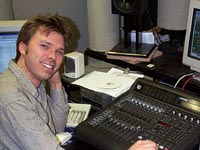
Craig Duman |
Planescape:
Torment shipped with the job of creating a full score for this
massive universe. The design included musical themes for each
of the main characters. Morgan's moody, and exotic style fit the
project perfectly. Although three weeks was a very tight schedule,
Craig Duman explains that, "because the music rolled in at the
last minute, I was able to balance the score against the finished
game." Craig made small volume and EQ adjustments to each musical
segment, molding the score to fit with the ambient sounds that
it would eventually play with. The music in Torment follows your
actions and the mood of the game interactively. As you prepare
to trounce your opponent, the droney ethereal background music
suddenly jumps into the foreground, morphing seamlessly into the
driving rhythm of battle music. Periodically, Mark's score seems
to disappear, melting into the rich ambient sound of the game.
Then quietly, the music steals back into gameplay, always shadowing
the action of the game. |
| Following
in the footsteps of the successful sound design in Baldur's Gate,
Interplay's audio department raised the standards of interactive
audio design even further in Planescape: Torment. Rave reviews
are coming in for music, sound effects, and dialog. Torment audio,"
as Craig Duman succinctly put it, "is Baldur's audio on steroids." |
Original URl: http://www.interplay.com/thegamer/klingon.html |


